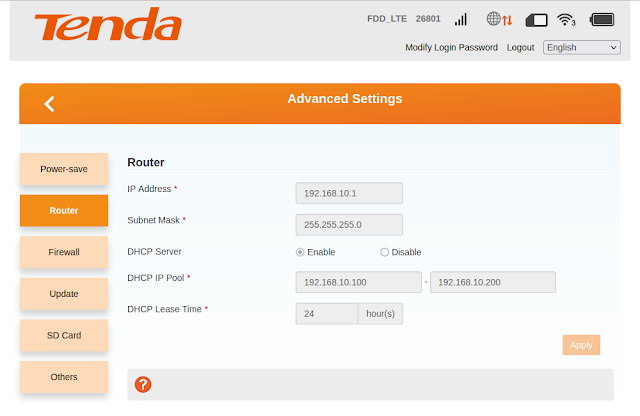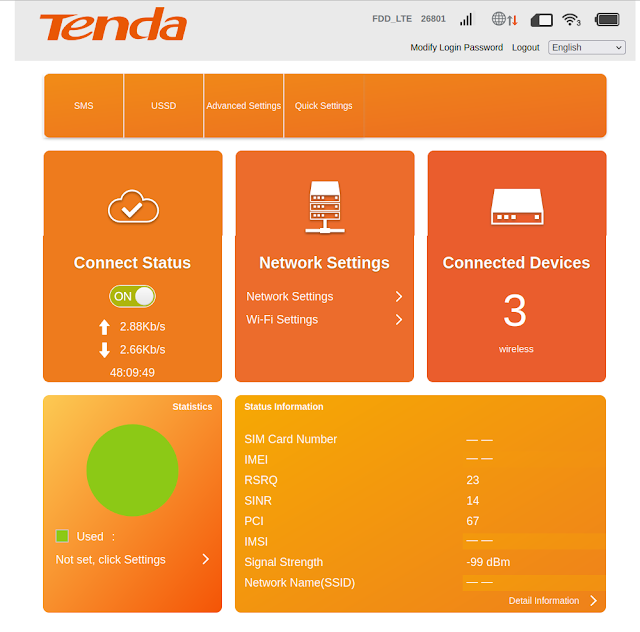The Tenda 4G185 is a 4G LTE Category 4 hotspot/MiFi device. It's specified to connect up to 10 devices by WiFi and to have a battery life of 10 hours.
The SIM (and optional SD card for sharing via the network) are installed inside the case, beneath the battery. The device supports both 4G and 3G networks.
It's not exactly a design classic - it has the rough appearance of an early flip phone, though it doesn't of course flip. It does have a colour display on the outside - pointlessly since the garish colours and poor resolution make it a worse choice than a monochrome screen.
The device does, however, have a couple of points in its favour. One is that you can remove the internal battery and leave it connected to a USB power source so that you don't reduce the life of the battery if you need the device powered on constantly. The second is that if you use a micro-USB data cable (the supplied cable supports power only) and plug it into a computer or similar host device, it emulates an ethernet adapter, so you can, at least in theory, access the mobile network with less overhead than via the normal WiFi route.
These theoretical advantages are somewhat undermined by two countervailing flaws. The first is that the device seems to lock up after a period of continuous use: I found I had to reboot if every 24-48 hours. The second is that it draws a significant amount of power: whilst it worked fine with a laptop, a GL-MT300N-V2 mini wireless router continuously rebooted as it couldn't deliver the required current.
Otherwise, the device performed reasonably well. It comes with a default address of 192.168.1.1 and has a configuration interface with both "Quick" and "Advanced" settings.
You can change the WiFi power levels if you want to extend the run time on batteries. I found the medium level more than adequate to cover a large room.
There's a status screen that gives you an overview of the state of connectivity and constantly updates the upstream and downstream traffic statistics.
A Category 4 device can theoretically deliver 150Mbit/sec downstream and 50Mbit/sec upstream, but it's very unlikely you'd get close to that except in laboratory conditions because so much depends on the signal at your location - and on how busy the network might be at any given moment. Using a wired connection, I have achieved 45Mbits/sec download and 35Mbits/sec upload; via WiFi, the best result I had was around 35Mbit/sec down and 30Mbit/sec up, which is quite reasonable for a device of this type in real world conditions.
You may wonder what, then, is the point of devices higher than Category 4. Well, they transmit and receive on several frequencies simultaneously which means that even if they can't use the full theoretical bandwidth of an individual channel, they can use multiple channels in parallel to increase the overall throughput - if the network allows. Such devices tend to be significantly more expensive, however.
You may well find that you actually get better performance from your mobile phone than from a MiFi-type device - at least for a short period of time. However, mobile phones aren't really designed to operate continually in this way and will likely throttle owing to increasing temperature. Even if they don't, you'll likely reduce the lifetime of the battery if they're used as a hotspot for extended periods.
For a relatively cheap device (£40-£50) the Tenda 4G185 delivers quite acceptable performance. Apart from the couple of flaws I've noted, other owners have complained that although the battery is removable, they've found it difficult or impossible to source replacements. Whereas they do appear to be available from China, the moral is clearly not to insert the battery only when you really need to operate without a source of USB power.




Comments
Post a Comment